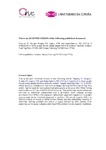A framework to learn graph theory using simple wireless network models

Use este enlace para citar
http://hdl.handle.net/2183/40011Colecciones
- Investigación (FIC) [1685]
Metadatos
Mostrar el registro completo del ítemTítulo
A framework to learn graph theory using simple wireless network modelsAutor(es)
Fecha
2016-11Cita bibliográfica
Dapena, A., Vázquez-Araujo, F.J., Castro, P.M. and Souto-Salorio, M.J. (2016), A framework to learn graph theory using simple wireless network models. Comput Appl Eng Educ, 24.6: 843-852. https://doi.org/10.1002/cae.21753
Resumen
[Abstract]: In order to improve the student learning process, we present a framework to define attractivecomputer laboratory lessons in Engineering Degrees. Theoretical concepts are illustrated from a practical point ofview using a graphical user interface designed to establish the relationship between wireless network models andgraph theory concepts. In this paper, we will explain some simple routing protocols to illustrate both Dijkstra’salgorithm and the graph dominant set.
Palabras clave
Wireless network
Graphical user interface
Graphical user interface
Descripción
This is the peer reviewed version of the article, which has been published in final form at https://doi.org/10.1002/cae.21753. This article may be used for non-commercial purposes in accordance with Wiley Terms and Conditions for Use of Self-Archived Versions. This article may not be enhanced, enriched or otherwise transformed into a derivative work, without express permission from Wiley or by statutory rights under applicable legislation. Copyright notices must not be removed, obscured or modified. The article must be linked to Wiley’s version of record on Wiley Online Library and any embedding, framing or otherwise making available the article or pages thereof by third parties from platforms, services and websites other than Wiley Online Library must be prohibited.
Versión del editor
Derechos
© 2016 Wiley Periodicals, Inc.
ISSN
1099-0542





